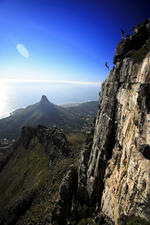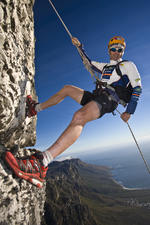For the Hang of It

Table Mountain is as beautiful a mound of rock as you will get. If you stand along the western edge of this legendary mountain, a panorama of singular beauty unfolds before you. To your left, the fynbos-covered ridges of the 12 Apostles stagger away towards Cape Point.
The Atlantic Ocean unfolds in a turquoise arc to your right, curving past Signal Hill to lap along the shores of Table Bay. Beneath your feet, the world drops away nearly a thousand metres to where the pearly beaches of Camps Bay and Clifton glitter along the coastline.
But right now you’re not enjoying the view, and this has a lot to do with the fact that you are about to step backwards off the edge of this magnificent mountain. And it is that first step that will be most difficult. You’re harnessed to a coil of kernmantel rope and below you, you can feel the suck of gravity snapping at your feet.
You must lean back into your harness, feeding out rope with your right hand while controlling your rate of descent. After ten metres or so, you reach a small ledge, and this is where the real deal kicks in.
A View to Die For
A quick peek over your shoulder pops the yawing magnitude of this thin air panorama into perspective. You’re a miniscule dot on a plummeting sandstone cliff face, with a parabola of sea and sky sweeping away towards the hazy horizon.
Around you, a great hush unfolds, and the rush of blood in your ears blocks out everything but the occasional screech of a swooping rock kestrel.
Your confidence soars as you descend further, kicking away from the face in great looping arcs as you feed the rope through the friction device, and you can feel the adrenaline thumping deep down in your gut. Half-way down the face, you hit a gaping overhang and spin into a spaced-out whirl of rock and sea and sky.
It is a view to die for, but hopefully not today. Welcome hands grab you as you touch down on terra firma after 112 m in thin air, and help you unclip from the rope and unbuckle your harness. The only thing between you and a cold beer is a steep, twenty-minute climb back up to the plateau, but you’ll feel so pumped you won’t even notice the ascent.
Abseil 101

History: Abseiling is not a sport as such, but rather a means used by climbers to quickly descend along a sheer face once they’ve scaled a mountain. The technique, also known as rappelling, is reputed to have originated when a Chamonix guide was forced to rope down during a failed solo climb in 1876.
Technique: Abseiling methodology may vary slightly between operators, but a basic system will always employ a fixed-line attached to a bomb-proof anchor. The abseiler is then attached to this rope with a descender or friction device (which controls your rate of descent), and this in turn is connected to the belay loop on your climbing harness.
During commercial abseils, it is common practice to employ a belay, or safety rope, to back up the abseiler while descending. Braking is performed by manipulating the angle of the main rope relative to the descender device, thereby controlling the friction and therefore your speed of descent.
First-time abseilers generally choose to step off backwards (always test-load the rope first!), then walk slowly down the cliff face while playing out the rope with their ‘brake hand’. As you become more confident, you will be able to kick away from the rock face to descend in great looping bounds. And once you’ve started vertigo in the face a few times, you may even decide to rappel down face first a la S.W.A.T. team style.
Equipment: You don’t have to worry about gear as far as recreational abseiling goes, as the operator will supply all the necessary technical equipment. What you will need is comfortable clothes, rugged footwear with good grip and a cap or hat to keep the sun off you. Remember that conditions in the mountains can change in an eye wink, so pack warm clothes and a shell just in case.
By Jacques Marais